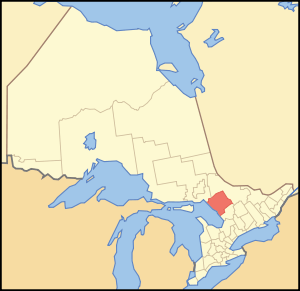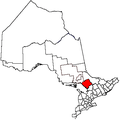Parry Sound District
| Parry Sound District | |
|---|---|
| District | |
 Location of Parry Sound District in Ontario | |
| Coordinates: 45°42′N 79°50′W / 45.700°N 79.833°WCoordinates: 45°42′N 79°50′W / 45.700°N 79.833°W | |
| Country |
|
| Province |
|
| Region | Northern Ontario and Central Ontario |
| Created | 1870 |
| Government | |
| • MPs | Tony Clement, Anthony Rota, Marc Serré |
| • MPPs | Norm Miller, Vic Fedeli |
| Area[1] | |
| • Land | 9,322.80 km2 (3,599.55 sq mi) |
| Population (2016)[2] | |
| • Total | 42,824 |
| • Density | 4.5/km2 (12/sq mi) |
| Time zone | UTC-5 (EST) |
| • Summer (DST) | UTC-4 (EDT) |
| Postal code FSA | P0C, P0E, P0G, P0H, P2A |
| Area code(s) | 705 |
| Seat | Parry Sound |
Parry Sound District is a census division of the Canadian province of Ontario. Its boundaries are District of Muskoka to the south, the Sudbury District to the north-northwest, the French River and Lake Nipissing in the north, Nipissing District and North Bay in the north and east and parts of Algonquin Park in the northeast.
In 2016, the population was 42,824. The land area is 9,322.80 square kilometres (3,600 sq mi); the population density was 4.5 per square kilometre (12/sq mi).[2]
Although geographically in Southern Ontario, the Ontario and federal governments treat it as it part of Northern Ontario. Like other census divisions in Northern Ontario, it does not have an incorporated county, regional municipality or district municipality level of government, instead serving as a purely territorial division like the other districts of Northern Ontario. In lieu of an upper tier of municipal administration, all government services in the district are provided either by the local municipalities or by the provincial government itself. Some communities which are not part of any incorporated municipality are served by local services boards. The district is also included in the service areas of FedNor and the Northern Ontario Heritage Fund. Accordingly, in most contexts the division is grouped with the Northern Ontario region instead of Southern Ontario.
Along with the neighbouring Muskoka and Haliburton regions, the Parry Sound District is considered part of Ontario's cottage country region. The district is commonly divided into two subregions; West Parry Sound and East Parry Sound, the latter often referred to as the Almaguin Highlands.
Subdivisions
| Towns | |
| Townships | |
| Villages | |
| Unorganized areas |
Local services boards in the unorganized areas: |
| First Nation reserves |
Original geographic townships
| Township | Unorganized | Incorporated | Annexed/Amalgamated |
|---|---|---|---|
| Armour | |||
| Bethune | Annexed by the Town of Kearney. | ||
| Blair | |||
| Brown | |||
| Burpee | Part of the Municipality of Whitestone. | ||
| Burton | Part of the Municipality of Whitestone. | ||
| Carling | |||
| Chapman | Part of the Municipality of Magnetawan. | ||
| Christie | Part of the Municipality of Seguin. | ||
| Conger | Part of the Municipality of the Archipelago, with a small part in the Municipality of Seguin. | ||
| Cowper | Part of the Municipality of the Archipelago. | ||
| Croft | Part of the Municipality of Whitestone, with a small part in the Municipality of Magnetawan. | ||
| East Mills | |||
| Ferguson | Annexed by McDougall Township. | ||
| Ferrie | Part of the Municipality of Whitestone. | ||
| Foley | Part of the Municipality of Seguin. | ||
| Gurd | Annexed by Nipissing Township. | ||
| Hagerman | Part of the Municipality of Whitestone. | ||
| Hardy | |||
| Harrison | Most became part of the Municipality of the Archipelago. | ||
| Henvey | Northern section was transferred to the Town of Killarney in Sudbury District. | ||
| Humphrey | Part of the Municipality of Seguin. | ||
| Joly | |||
| Laurier | |||
| Lount | |||
| Machar | |||
| McConkey | |||
| McDougall | |||
| McKellar | |||
| McKenzie | Part of the Municipality of Whitestone. | ||
| McMurrich | Part of the Township of McMurrich/Monteith. | ||
| Monteith | Western two-thirds became part of the Municipality of Seguin, while the eastern third became part of the Township of McMurrich/Monteith. | ||
| Mowat | Part transferred to the Town of Killarney in Sudbury District | ||
| North Himsworth | Now the Municipality of Callander. | ||
| Nipissing | |||
| Patterson | |||
| Perry | |||
| Pringle | |||
| Proudfoot | Annexed by the Town of Kearney. | ||
| Ryerson | |||
| Shawanaga | Most became part of the Municipality of the Archipelago. | ||
| South Himsworth | Annexed by the Municipality of Powassan. | ||
| Spence | |||
| Strong | |||
| Wallbridge | |||
| Wilson |
Demographics
| Canada census – Parry Sound District community profile | |||
|---|---|---|---|
| 2016 | 2011 | 2006 | |
| Population: | 42,824 (1.6% from 2011) | 42,162 (3.0% from 2006) | 40,918 (3.2% from 2001) |
| Land area: | 9,326.48 km2 (3,600.97 sq mi) | 9,322.80 km2 (3,599.55 sq mi) | 9,222.04 km2 (3,560.65 sq mi) |
| Population density: | 4.6/km2 (12/sq mi) | 4.5/km2 (12/sq mi) | 4.4/km2 (11/sq mi) |
| Median age: | 52.6 (M: 52.3, F: 53.0) | 47.9 (M: 47.3, F: 48.4) | |
| Total private dwellings: | 35,226 | 33,764 | 35,404 |
| Median household income: | $46,180 | ||
| References: 2016[2] 2011[1] 2006[3] earlier[4] | |||
- 93.8% White
- 5.5% Aboriginal (3.8% First Nations, 1.5% Métis)
- 0.7% Visible Minorities
Forest fire protection history
The Parry Sound Forest Fire District was founded by Ontario's former Department of Lands and Forests (now the MNR) in 1922 as one of 17 districts to help protect Ontario's forests from fire by early detection from fire towers. The headquarters for the district were housed in the town of Parry Sound. It was the central location for 21 fire tower lookouts, including the Parry Sound fire tower, which was erected in the same location as the modern lookout tower at 17 George Street. The other 20 towers in the district were: Pickerel River CPR, Byng Inlet, Still River, Pointe au Baril, Pakesley, Pickerel River CNR, Key Junction, Ardbeg, Spence, Go Home, Loring, Stormy Lake (Restoule), Nipissing, Boulter, Lount, Laurier, Strong, Proudfoot, Stisted and Draper. When a fire was spotted in the forest a towerman would get the degree bearings from his respective tower and radio back the information to headquarters. When one or more towermen from other towers in the area would also call in their bearings, the forest rangers at headquarters could get a 'triangulation' read and plot the exact location of the fire on their map. This way a team of forest firefighters could be dispatched as soon as possible to get the fire under control. In 1969 there remained only 4 actively manned towers: Ardbeg, Go Home, Stormy Lake, and Boulter. These would all be phased out shortly after when aerial fire fighting techniques were employed in the 1970s.
See also
References
- 1 2 "2011 Community Profiles". Canada 2011 Census. Statistics Canada. July 5, 2013. Retrieved 2012-03-19.
- 1 2 3 "Parry Sound District census profile". 2016 Census of Population. Statistics Canada. Retrieved 2018-01-18.
- ↑ "2006 Community Profiles". Canada 2006 Census. Statistics Canada. March 30, 2011. Retrieved 2011-08-22.
- ↑ "2001 Community Profiles". Canada 2001 Census. Statistics Canada. February 17, 2012.
External links
| Wikimedia Commons has media related to Parry Sound District, Ontario. |
- Parry Sound Tourism
- The Parry Sound Area Chamber of Commerce
- Parry Sound and Area information
- Map of Parry Sound District showing its municipalities
- Rooted in Stone: Reflections on West Parry Sound's Past
- Almaguin Highlands Ontario East Parry Sound's Almaguin Highlands Regional Portal
- Almaguin Highlands Digital Collection A service of Knowledge Ontario
